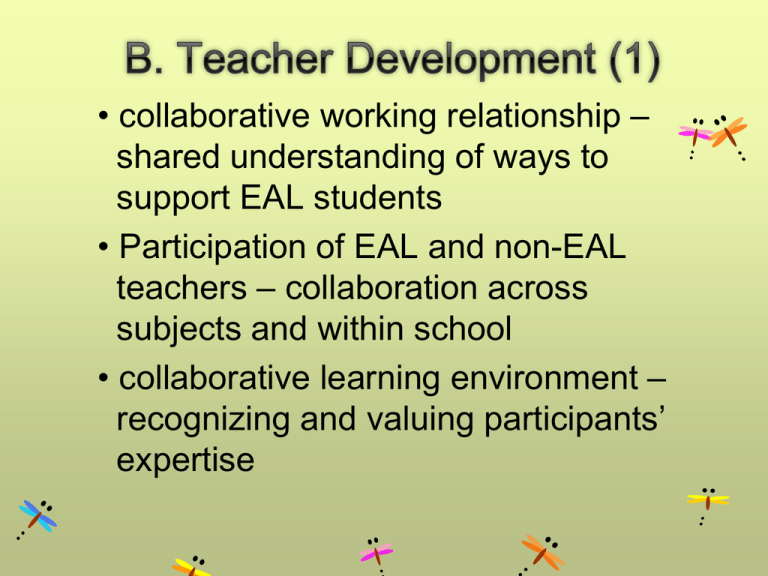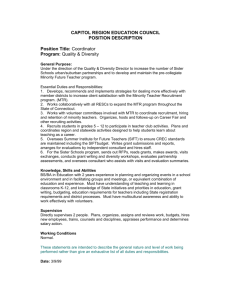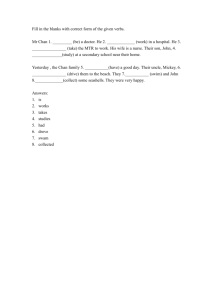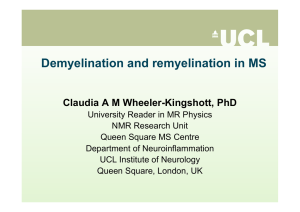PowerPoint presentation - Outcomes of the teacher development course by Tse PikYuk
advertisement

• collaborative working relationship – shared understanding of ways to support EAL students • Participation of EAL and non-EAL teachers – collaboration across subjects and within school • collaborative learning environment – recognizing and valuing participants’ expertise • activity design – participants undertaking, examining and reflecting • new culture of classroom observation - trial suggested strategies - peer support - positive sharing between young and experienced teachers Challenges Solutions Time constraint - tight teaching schedules - customized schedule design with school support - 50 CPD hours - Accreditation Heavy workload - 5 BMRs (Between Module Readings) reflecting critically, deeper understanding between theories and practice - 5 BMAs (Between Module Activities) process of trialling strategies - roster - reflect critically - amazing presentations - action plan – collaboration work Challenges Intimidating learning environment Solutions - content wide-ranging and comprehensive - lots of highly interactive hands-on activities - teacher as facilitator – guiding participants to reflect on pedagogy - friendly and supportive atmosphere – full of fun and laughter D. Learning Outcomes (1) 1. Effectiveness - Integrated Science teacher, Mr. Sunny Lam - confidence boosted - language use in classroom improved - applied strategies learnt to lessons, helping students understand written texts to support learning - DOLACEE sharing session D. Learning Outcomes (2) 2. DOLACEE Action Plan + School Lesson Study - NOT an add-on - School Lesson Study – collaboration tailor-making lessons first tryout peer observation evaluation second tryout evaluation - Strategies applied in the lessons of Ms Irene Wong, an English teacher. D. Learning Outcomes (3) 3. DOLACEE application in the classroom A DOLACEE tutor conducting two lessons with 3 classes each on “How to read English newspapers with a schematic structure.” 4. DOLACEE – second phase - Mentoring programme for a Math teacher and a History teacher D. Learning Outcomes (4) 5. Train-the-trainer (seeding) in-house training + collaboration (fertilizing) mindset change (weeding) application in classroom (reaping harvests) whole-school approach (reaping bumper harvests) Module No of Hours 1 3 2 2.5 3 3 4 2.5 5 3 6 3 7 3 8 2.5 9 2.5 Details of workshops ESL students and learning in a second language Language and learning and the role of scaffolding Oral language: how the task shapes the talk Using oral language: interpreting and producing oral texts Working with written and visual texts Working with written and visual texts at the text level Developing knowledge of genre and language at the language level Assessing written texts Programming and wholeschool models of support for ESL students Date Time 28 Nov 08 (Fri) (SD Day) 11:00 a.m. 9 Dec 08 (Tue) (Exam Period) 1:40 p.m. *teachers have to swap lessons on their own for the afternoon sessions starting 1:40pm 16 Dec 08 (Tue) (Exam Period) 23 Dec 08 (Tue) (Exam Period) 16 Feb 09 (Mon) (Sports Day) 19 Mar 09 (Thu) (before SD Day) 23 April 09 (Thu) (Prep for Open Day) 2 June 09 (Revision Week) 9 June 09 (Exam Period) Venue Room 611 The layout of the Periodic table can be explained by the History of the content for higher form students, but it is too difficult for F.3 students. A hyperlink (History of the periodic table) is more suitable for F.3 level. Main headings, sub-headings for different stages of the development of the Periodic table are given with examples. Layout of the text in the website Main headings/Sub-headings – boldface with different sizes Reference and additional information – italics Technical terms – hyperlinks Different colours – different element categories Tips to use the website of Periodic table Compare the text from the website and the text in the textbook to identify the information required for F.3 level. Example Chemical elements - Elements are substances which cannot be broken down into anything simpler. (textbook) Chemical elements - A chemical element is a pure chemical substance consisting of one type of atom distinguished by its atomic number, which is the number of protons in its nucleus. (website) Tips to use the website of Periodic table Unpack the dense nominalization for the students Example The alkali metals provide one of the best examples of group trends in properties in the periodic table, with well characterized homologous behavior down the group. Key noun Pre-modifier Post-modifier Please behave on the MTR (adapted from the star letter on February 27,2009) I'm sure many of you use the MTR. It's safe, fast and comfortable. More than 4.3 million people ride on MTR trains every day. It's an essential part of Hong Kong's success as an international city. Unfortunately, not all of the passengers behave well and I think a lot of things should be done to change the situation. Firstly, I have been very disappointed by some people's selfish behaviour on the MTR. I have seen people blocking doorways, kissing or failing to move in for other passengers. In general, I don't think people behave well enough on the MTR. To change this, we need to start with adults. Children copy their parents' behaviour. Good values and behaviour are learned at an early age. The government should do more to promote good behaviour on all public transport, not only on MTR trains. It could make use of posters, advertisements or interesting characters to spread the message. The MTR should also hire more staff to monitor passengers' behaviour and punish those who break the rules. Ava Cheng, Our Lady of the Rosary College Title Introduction 1st Topic Sentence elaboration 2nd Topic Sentence elaboration Dear Editor I’m writing to respond to Ava Cheng’s letter about people’s misbehavior on the MTR. I strongly agree with Ava that people should be more civic-minded. As the MTR has one of the best transport systems in the world, everyone expects to have a pleasant journey. However, many people share Ava's unhappy experience. Actually, people in other countries also show some misbehaviour and there is a lot to be done in order to save the image of Hong Kong. Hong Kong people are not alone in abusing our trains. On a recent trip to Seoul, I saw electronic notice boards demonstrating what not to do while riding the train, and London is also infamous for its dirty Tube. But this does not mean we should follow suit. I agree with Ava that the family, government and MTR company should so something to promote the sense of civic-mindedness. The parents should be good role models for their children. The government can use some Disney characters or movie stars to spread the message. The MTR company should also hire more part-time staff to patrol the train compartments as well as the station. Besides, it is time everyone did our part to change the situation. First, we should try tobe considerate when riding the MTR. I would suggest offering our seat to those passengers in need – the elderly, the disabled, pregnant women and people with small children. We shouldn’t push through the door, or run into the carriage as the doors are closing. When we use our mobile phones, we should speak softly and mind our language. We shouldn't eat or drink on the train. It will make the seat dirty and messy for other people who board after us. Wouldn’t it be a good idea if kissing could be banned on the MTR? So, they won't bloc the doorways and other people will not feel embarrassed. In conclusion, everyone has the responsibility to behave ourselves. If we all behave properly on public transport, we can be proud of ourselves as well as our wonderful MTR. Yours faithfully, Chris Wong Greeting Introduction 1st Topic Sentence elaboration 2nd Topic Sentence elaboration Bad behaviour on buses (adapted from the star letter on March 2, 2009) I hate traveling by bus! But I have to catch the bus to school every day. I'm fed up with the people who do not behave themselves on buses. Some people do not know the importance of personal hygiene. Sometimes when my friends and I are sitting and chatting happily, someone behind us starts coughing or sneezing. Some people never use tissues to cover their mouths. It is disgusting. We then have to sit with our mouths closed to avoid getting infected, and we can’t chat until we leave the bus. Besides, people who sit with their legs pushing into the seat in front are also very irritating. In addition, it is selfish of some people to eat or drink on buses. Some people even leave their food or tissues on the seats. After a hard day at school, all I want is a little rest on the bus. But suddenly I find I am sitting in a mess left by someone else, and my uniform is too dirty to be worn to school the next day. What can we do to change the situation? I really wish people would be more considerate. Martin Tsang Title Introduction 1st Topic Sentence elaboration 2nd Topic Sentence elaboration




